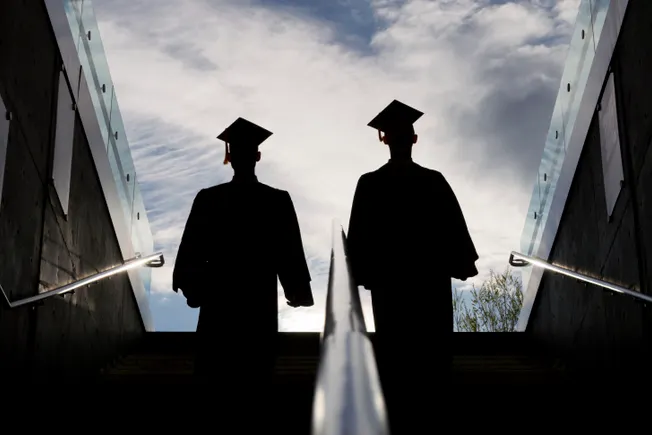patpitchaya/Shutterstock
When we stepped into our leadership roles, we didn’t know that a shared calendar invite and weekly trips to Starbucks could eventually lead to transformational change. As the Chief Academic Affairs Officer and the Chief Student Affairs Officer at a community college in the Northeast, we had both noticed that academic and student service areas often had some general overlapping goals but limited collaboration. In fact, we had seen examples in which the leaders of those two areas would not talk to each other at all. Sometimes, those in the academic arena may see student services as party planning with some athletic offerings that lead to missed class time or admissions folks responsible just to fill seats; while the student services area may see academics as just a bunch of memorization and chalk talk with unnecessarily harsh instructors failing their athletes and advisees. In reality, both areas contribute to teaching and learning, cultural enrichment, and a vibrant campus life experience — which are all vital to a student’s overall experience.
We soon realized our shared goal was increasing enrollment and fostering a positive student experience on our campus, so how could we work to unite two areas that did not seem to have much in common at the surface?
We started small, and so can you.
Our weekly meetings started out simple: checking in on upcoming priorities, troubleshooting challenges, and aligning our work with the president’s vision. These early conversations, which were sometimes awkward and not always pleasant, became the foundation of a more integrated, student-centered culture. The meetings started out very reserved, but the more we met, the more comfortable we felt having more challenging conversations that ultimately pushed the needle.
Over time, some of the steps we took to reduce the work silos included:
Attending each other’s events (example: program pinning ceremonies and athletic events). Creating an on-the-spot registration day at the high schools with our admissions team and our academic advising team. Creating a programming fund that allowed funding for faculty to host activities on or off campus (open mic night, trip to Boston, published book of student poetry). Implementing a Dean’s Advisory Group of students to get feedback for both academics and student services from various students on campus. Collaborating to ensure departmental documents and policies aligned. Establishing a joint meeting with the president so that all of our work and ideas were discussed together and everyone received and heard information at the same time.
Easy, right? Nope.
We want to be clear. Aligning these two areas on campus will require a lot of work, or there may be times you are annoyed with each other (we will get to that). However, you will reap the benefits of these collaborations and so will the students, the folks who report to you, and even your college president. In our situation, these benefits were:
Most credentials awarded in college history in 2024. High school exploration blocks created to facilitate discussions with high school dual enrollment students. Faculty-led engagement on campus. Creation of student coaches/advising center. Increased enrollment by 10% year over year for three years in a row.
The more success we found in collaboration, the more we challenged the norms. We continued to dig deeper into the remaining silos and pushed to ensure that our two areas of the college were working in tandem. As the leaders of these two areas, it was important that we modeled collaboration and connectivity between academics and student services, so that we could encourage this amongst the staff in our areas. For example, we started to create these collaborative relationships between our directors. In what started as required meetings, the directors began to find common ground and started connecting more frequently and less formally on their own as issues and concerns arose within their departments.
So, what about those annoying days?
Bridging the gap between these two areas of the institution is not always rainbows and butterflies. It is important to recognize there will be push and pull. There were times when we could not come to an agreement after hours of back and forth, but ultimately, we had to rely on our shared purpose — student success. If both of the leaders on your campus are invested in what is best for the students, and we were, sometimes that means that you need to compromise or find a unique way to achieve a particular outcome; thinking as if the box does not exist. We never let our egos get in the way of achieving our shared purpose.
Replicating This on Your Campus
You can build this relationship on your campus too, even if you are total opposites (we are — most people see us as Wednesday Addams and Enid Sinclair). A simple guide is to:
Find the shared purpose. Start with the easy wins in collaboration. Have the deeper conversations and break down silos. Pivot when needed. Outline strategies for next steps.
At the heart of higher education, we are here to make an impact on the lives of students. We have an opportunity to change the trajectory of a family tree. You have to remember collaboration between academic and student services is not about choosing sides — it is about choosing students.






![[Podcast] EdTech Evolution | Higher Ed Dive [Podcast] EdTech Evolution | Higher Ed Dive](https://imgproxy.divecdn.com/VUblH9e_Wy3fxAzne7ks4nHDDtEcUBeZqEyQwohnOfk/g:ce/rs:fit:770:435/Z3M6Ly9kaXZlc2l0ZS1zdG9yYWdlL2RpdmVpbWFnZS9WaXRhbFNvdXJjZV9IaWdoZXJFZERpdmVfUG9kY2FzdF8wNTAxMjVfQ292ZXJJbWFnZV9GSU5BTC5wbmc=.webp)





















